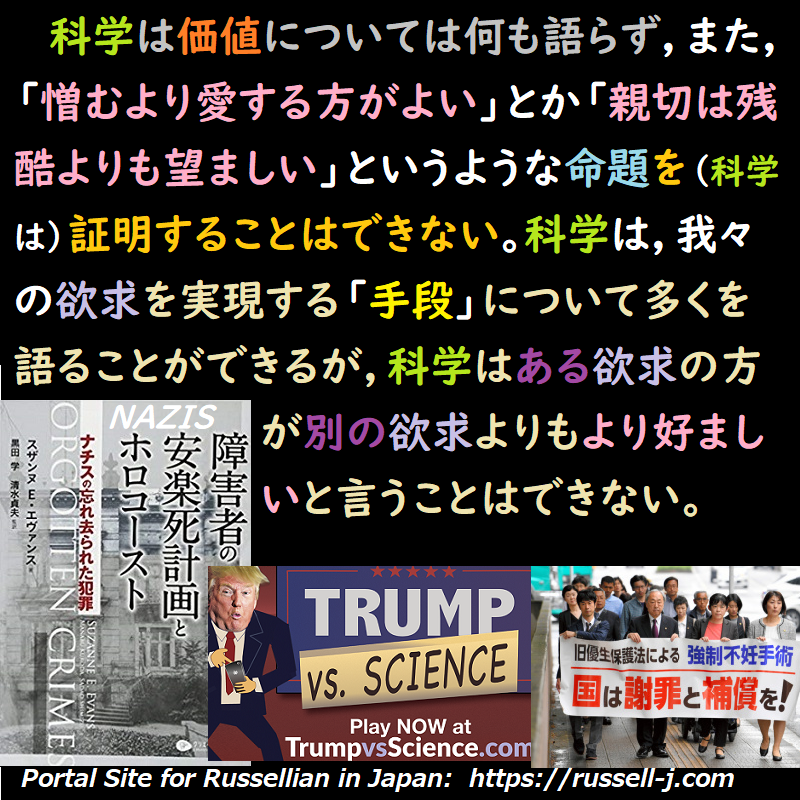それ故に(thus こうして),アーサー・トムソン卿(John Arthur Thomson, 1861-1933:英国スコットランドの生物学者,博物学者。講演や執筆活動を行う事により、科学と宗教の関連性や生物学の普及に務めた。)は次のように言っている。「科学としての科学(Sceince as science 学問としての科学)は「なぜ?(どうして?)」という問いを(自らに対し)決して発しない。即ち,この(科学という)多様な存在の現在の有り様(Being),なりつつあるもの(Becoming),これまであり続けたもの(Having Being)の意味や意義や目的について問わない」。また続けてこう言っている。(即ち)「このようにして,科学は真理の岩盤であるふりをしない」し,「科学は科学の方法を神秘的なものや霊的なものに適用することができない」と彼は語っている。J. S. ホールデン教授(J. B. S. Haldane, 1892-1964:イギリスの生物学者(集団遺伝学)は,「我々が神の啓示を見出すのは,我々自身のなかと,真理,正義,慈愛,美という我々の実践的理想,及び,その結果として生じる友情(consequent fellowship)の中においてのみである」という考えを抱いている(Haldane holds)。(また)マリノウスキー博士は「宗教的啓示は,原理的に,科学の領域を超えたところに存在している」と言っている。私は,当面,神学者たちの意見は引用しないことにする。なぜなら,彼らがこういった意見(見解)と同意することは予想できるからである。 さらに先に進む前に,(以上で)主張内容(何が主張されているのか),また,その主張の真偽について,明らかにするよう試みてみよう。聖堂参事会員(Canon)のストリーター「科学は十分なものではない」という時,ある意味で,彼は自明のことを言っている(にすぎない)。科学は,芸術や友情やその他の人生に於ける様々な価値的要素を含んでいない。しかし,もちろん,彼の発言はそれ以上のことを意味している。「科学は十分なものではない(不充分である)」ということには別のもっと重要な意味があり,それも私には真理であると思われる。(即ち,)科学は価値については何も語らず,また,「憎むより愛する方がよい」とか「親切は残酷よりも望ましい」というような命題を(科学は)証明することはできない。科学は,我々の欲求を実現する「手段」について多くを語ることができるが,科学はある欲求の方が別の欲求よりもより好ましいと言うことはできない。このことは大きな主題であり,後の章でもっと言及しなければならないだろう。 しかし,私が(先に)引用した著者たちはそれ以上のことを主張しようとしているのは確かであり,私はそれは誤っていると信じる。(たとえば)「科学は『真理』の岩盤であるふりをしない」(『』で囲んだのは筆者=ラッセル)という主張は(主張には),真理に到達する科学とは別の,非科学的な方法があるという意味を含んでいる。(また)「宗教的啓示は・・・科学の領域を超えたところに存在している」という発言は,この非科学的な方法が何であるかについて何らかのことを語っている。(つまり)それは宗教的啓示の方法である。 聖堂参事会長(Dean 主席司祭)のインゲ(William Ralph Inge, 1860-1954:ケンブリッジ大学の神学教授,セント・ポール大聖堂の主席司祭 )はもっと明確にいっている。(即ち)「宗教の証拠は,その場合(then),実験的な(exprimental)ものである」【彼は神秘主義者の証言(testimony)について語っている】(またインゲは)「それ(宗教の証拠)は,神が自ら人類に啓示した3つの属性 -時に絶対的な価値あるいは永遠の価値と呼ばれる- (つまり)善あるいほ愛,真,美,(注:日本では「真・善・美」の順)をそなえた神についての革新的な知識である。もし,そうなら(それが全てなら),,宗教が自然科学と衝突する理由はまったくないとあなたは言うであろう。一方は事実(の問題)を扱い,他方は価値(の問題)を扱う。両者とも本当だとすると,両者は異なった次元(planes 平面)にいる。だがそれは必ずしも正しくない(This is not quite true)。科学が,倫理や詩やその他いろいろ(and what not)に侵入するのを見てきた。宗教はどちらにも侵入せざるを得ない」(訳注:以上は,インゲの主張)。つまり,宗教は(事実が)何であるかについても主張しなければならず,何をすべきかについてだけ言っていればよいのではない。(荒地出版社刊の津田訳は次のように「宗教自身」のことしか触れておらずずれいる。即ち「宗教は自己の現状について確乎たる主張をしなければならないのであり,自己のあるべき状態についてのみ主張するに止まってほならないというのである。」)。このようなインゲ氏によって公言されたこの見解は,アーサー・トムソン卿やマリノウスキー博士の言葉の中にも内包されている(暗に含まれている)のである。
Chapter 7: Mysticism, n.3 Thus Sir J. Arthur Thomson says : ”Science as science never asks the question Why ? That is to say, it never inquires into the meaning, or significance, or purpose of this manifold Being, Becoming, and Having Been.” And he continues : “Thus science does not pretend to be a bedrock of truth.” “Science,” he tells us, “cannot apply its methods to the mystical and spiritual.” Professor J. S. Haldane holds that “it is only within ourselves, in our active ideals of truth, right, charity, and beauty, and consequent fellowship with others, that we find the revelation of God.” Dr. Malinowski says that “religious revelation is an experience which, as a matter of principle, lies beyond the domain of science.” I do not, for the moment, quote the theologians, since their concurrence with such opinions is to be expected. Before going further, let us try to be clear as to what is asserted, and as to its truth or falsehood. When Canon Streeter says that “science is not enough,” he is, in one sense, uttering a truism. Science does not include art, or friendship, or various other valuable elements in life. But of course more than this is meant. There is another, rather more important, sense in which “science is not enough,” which seems to me also true : science has nothing to say about values, and cannot prove such propositions as “it is better to love than to hate” or “kindness is more desirable than cruelty.” Science can tell us much about the means of realizing our desires, but it cannot say that one desire is preferable to another. This is a large subject, as to which I shall have more to say in a later chapter. But the authors I have quoted certainly mean to assert something further, which I believe to be false. “Science does not pretend to be a bedrock of truth” (my italics) implies that there is another, non-scientific method of arriving at truth. “Religious revelation . . . lies beyond the domain of science” tells us something as to what this non-scientific method is. It is the method of religious revelation. Dean Inge is more explicit : “The proof of religion, then, is experimental.” [He has been speaking of the testimony of the mystics.] “It is a progressive knowledge of God under the three attributes by which He has revealed Himself to mankind – what are sometimes called the absolute or eternal values – Goodness or Love, Truth, and Beauty. If that is all, you will say, there is no reason why religion should come into conflict with natural science at all. One deals with facts, the Other with values. Granting that both are real, they are on different planes. This is not quite true. We have seen science poaching upon ethics, poetry, and what not. Religion cannot help poaching either.” That is to say, religion must make assertions about what is, and not only about what ought to be. This opinion, avowed by Dean Inge, is implicit in the words of Sir J. Arthur Thomson and Dr. Malinowski.
出典:Religion and Science, 1935, chapt. 7:
情報源:https://russell-j.com/beginner/RS1935_07-030.HTM

